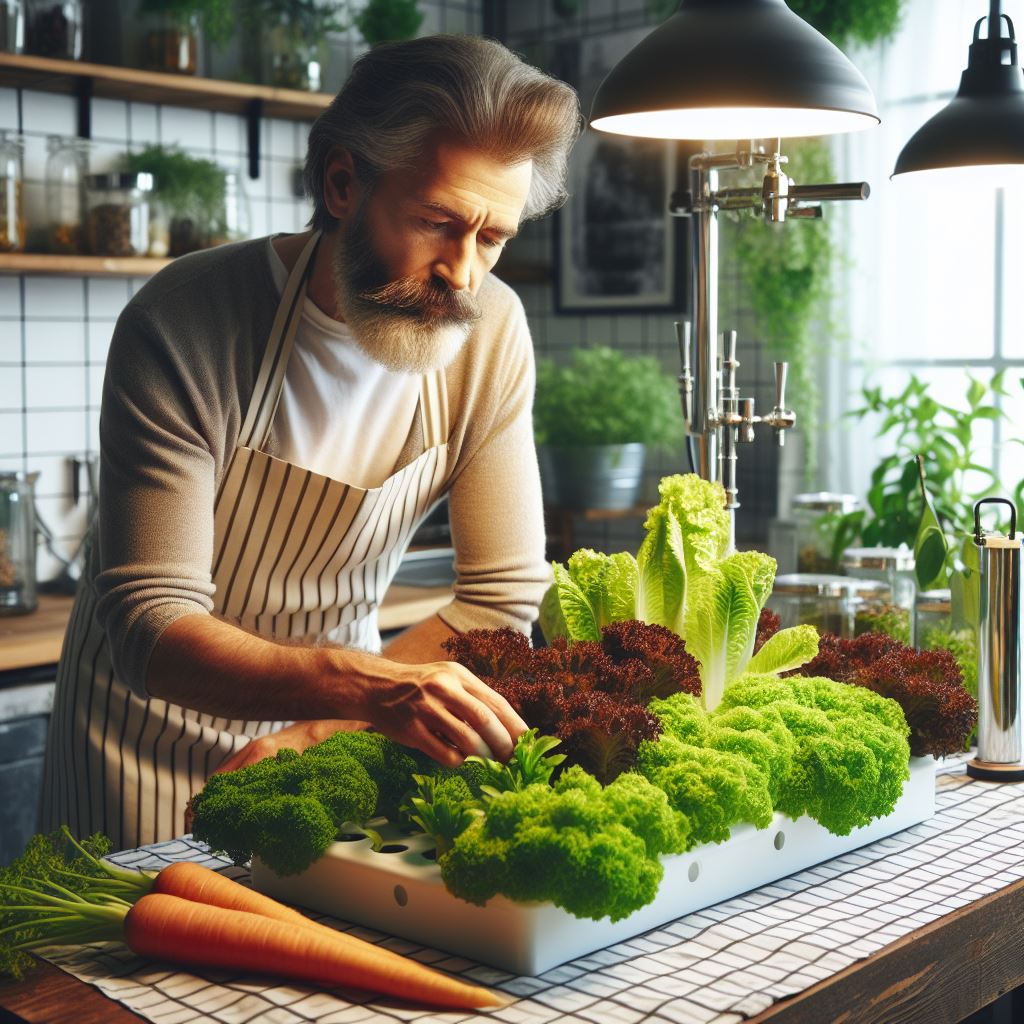Kitchen Garden: Hydroponics for Beginners
Last Updated on February 26, 2024
Introduction
Hydroponics is a unique method of growing plants without soil.
It involves using nutrient-rich water to cultivate plants.
This innovative technique has gained popularity in recent years due to its numerous advantages.
One of the key benefits of kitchen gardens is the ability to grow fresh produce right at home.
With hydroponics, you can grow a variety of herbs, vegetables, and even fruits, regardless of the season.
By having access to fresh and organic ingredients, you can enhance the taste and nutritional value of your meals.
Moreover, kitchen gardens contribute to sustainability.
They reduce the need for transportation and packaging associated with store-bought produce.
Hydroponics also uses significantly less water than traditional soil gardening.
By growing your own food, you reduce your carbon footprint and contribute to a healthier planet.
This blog post aims to provide beginners with the knowledge and motivation to start their own hydroponic kitchen garden.
Whether you have limited outdoor space or are simply looking for a new hobby, hydroponics is a great option.
We will cover the basics of setting up a hydroponic system, choosing the right plants, and maintaining optimal growth conditions.
By the end of this post, you will be equipped with the necessary information to embark on your hydroponic gardening journey.
Get ready to enjoy the benefits of fresh, homegrown produce, all year round.
Benefits of Hydroponics
Hydroponics offers a range of benefits that make it a popular choice for gardening enthusiasts. Let’s explore these advantages in detail:
No need for soil
One of the most significant benefits of hydroponics is that it eliminates the necessity for soil.
This is especially advantageous in urban areas where space is limited.
Hydroponic systems use a water-based nutrient solution to provide plants with everything they need to grow, replacing the function of soil.
By doing away with traditional gardening soil, hydroponics allows for more flexibility in terms of location and setup.
It makes it possible to grow plants indoors, in greenhouses, or even on rooftops.
This opens up opportunities for individuals who don’t have access to large garden areas.
Efficient use of water and nutrients
Hydroponics is a highly efficient method of growing plants as it utilizes water and nutrients more effectively.
Traditional gardening often leads to water runoff and nutrient leaching, resulting in wastage and environmental pollution.
Through hydroponics, water and nutrients are delivered directly to the roots of the plants, ensuring they receive exactly what they need.
The use of a closed-loop system or recirculating setup further minimizes water consumption, making hydroponics an eco-friendly choice.
Faster growing time
One of the main advantages of hydroponics is the significant reduction in growing time compared to traditional gardening.
The controlled environment and optimized nutrient delivery allow plants to grow more rapidly.
In a hydroponic system, plants have constant access to essential nutrients and water.
The absence of competition for resources combined with optimal conditions promotes faster growth.
This makes hydroponics ideal for those who want to enjoy the results of their labor in a shorter time frame.
Ability to grow plants all year round
With hydroponics, gardening is no longer limited to specific seasons or weather conditions.
The controlled environment provided by hydroponic systems allows plants to thrive regardless of the external climate.
By adjusting factors like temperature, humidity, and lighting, hydroponic gardeners can create the perfect conditions for their plants to grow and thrive.
This makes it possible to cultivate a wide variety of plants throughout the year, providing a constant supply of fresh produce regardless of the season.
In short, hydroponics offers numerous benefits that make it an attractive option for beginner gardeners and enthusiasts alike.
From eliminating the need for soil to ensuring efficient resource utilization, hydroponics revolutionizes the way we grow plants.
Its accelerated growth rate and year-round gardening capabilities further add to its appeal.
So why not give hydroponics a try and experience the advantages firsthand?
Read: Eco-Friendly Farming: Aquaponics Insights
Getting Started with Hydroponics
In order to successfully grow plants using hydroponics, there are several important factors to consider before diving into this innovative gardening method.
This section will guide you through the initial steps of getting started with hydroponics.
Choosing the right location
- Find a suitable location for your hydroponics system, preferably indoors or in a greenhouse.
- Ensure the area has adequate access to natural light or install artificial grow lights.
- Consider the temperature and humidity levels of the location, as it can impact plant growth.
Selecting appropriate plants for hydroponics
- Choose plants that are well-suited for hydroponic cultivation, such as leafy greens, herbs, and tomatoes.
- Research each plant’s specific requirements regarding pH levels, nutrient concentrations, and growth conditions.
- Start with easy-to-grow plants for beginners, such as lettuce or basil, to gain confidence and experience.
Gathering necessary equipment
- Acquire a hydroponic system, which can vary from simple DIY setups to more advanced systems.
- Purchase containers or trays to hold the plants, as well as a nutrient solution and growing medium.
- Make sure you have proper tools for monitoring pH levels, temperature, and nutrient levels in the water.
Understanding the different types of hydroponic systems
- Learn about the various hydroponic system options, such as nutrient film technique (NFT), deep water culture (DWC), or drip systems.
- Each system has its advantages and limitations, so choose one that aligns with your preferences and available resources.
- Research and familiarize yourself with the maintenance requirements of the chosen system to ensure successful plant growth.
Essentially, before embarking on your hydroponic gardening journey, make sure to carefully consider the location, plant selection, equipment, and system type.
By taking these initial steps, you will be well-prepared to begin your hydroponics adventure and achieve successful plant growth.
Read: Indoor Eden: Hydroponic Systems for Home
Setting Up a Basic Hydroponic System
Step-by-step guide for building a basic system
- Select a suitable location for your hydroponic system, preferably near a water source and access to electricity.
- Choose a container for your plants, such as a hydroponic tray or pots, ensuring they have drainage holes.
- Fill the container with a growing medium like perlite or coconut coir, which will support the plant roots.
- Decide on the type of hydroponic system you want to build, such as a Deep Water Culture or Nutrient Film Technique system.
- Set up a reservoir to hold the nutrient solution, ensuring it’s large enough to provide a continuous supply to the plants.
- Connect air stones or diffusers to the reservoir to oxygenate the nutrient solution for healthier plant growth.
- Install a submersible water pump in the reservoir to circulate the nutrient solution and provide a constant flow to the plants.
- Attach timers to the water pump to control the feeding schedule and ensure the plants receive the right amount of nutrients.
- Place the container with the growing medium and plants in direct contact with the nutrient solution.
- Adjust the pH levels of the nutrient solution using pH testing kits, making sure it’s within the optimal range for your chosen plants.
- Install grow lights above the plants if you’re unable to provide sufficient natural sunlight.
- Monitor the system regularly and make adjustments as necessary, including nutrient solution levels, pH, and water pump operation.
Key components (containers, pumps, timers, etc.)
In a hydroponic system, containers are used to hold the growing medium and provide support for the plants.
These can be trays or pots, as long as they have proper drainage holes to prevent waterlogging.
Pumps are crucial in circulating the nutrient solution from the reservoir to the plants.
Submersible water pumps are commonly used, ensuring a constant flow and supplying adequate oxygen to the roots.
Timers play a significant role in controlling the feeding schedule of the plants.
By setting specific intervals, timers ensure that the nutrient solution reaches the plants consistently and avoids over or under-feeding.
Proper installation of the system
When setting up a hydroponic system, it’s essential to follow proper installation guidelines for optimal plant growth.
Firstly, select a suitable location that has access to water and electricity.
This will make it easier to maintain the system and adjust nutrient solution levels when needed.
Next, ensure the containers you choose have adequate drainage holes to prevent waterlogging, which can lead to root rot.
A suitable growing medium, such as perlite or coconut coir, provides the necessary support for the plant roots.
Proper installation of the reservoir, water pump, and timers is crucial for the system’s function.
Connect air stones or diffusers to the reservoir to oxygenate the nutrient solution, promoting healthier plant growth.
Once the system is set up, ensure that the pH levels of the nutrient solution are within the optimal range for your specific plants.
Regular monitoring and adjustments, such as nutrient solution levels and water pump operation, are vital for a successful hydroponic system.
By following these guidelines, you can set up a basic hydroponic system and enjoy the benefits of growing your own fresh and healthy produce.
Read: Fish-Powered Gardens: Aquaponics Guide
Nutrient Solutions and Feeding Plants
In hydroponics, nutrient solutions play a crucial role in providing essential elements for plant growth.
Importance of Nutrient Solutions in Hydroponics
One of the primary advantages of hydroponics is the ability to control and optimize nutrient availability for plants.
Nutrient solutions are carefully formulated to provide plants with all the necessary elements for optimal growth.
Unlike traditional gardening, where soil quality varies and nutrients may be limited or imbalanced, hydroponic systems provide a consistent and controlled environment for plants to thrive.
By supplying plants with nutrient-rich solutions directly to their roots, hydroponics ensures efficient nutrient uptake, leading to faster growth rates and higher yields.
The Role of Essential Nutrients
Essential nutrients are the building blocks of plant growth and development.
They are involved in various physiological processes, ranging from photosynthesis and respiration to root development and fruit production.
Macronutrients such as nitrogen, phosphorus, and potassium are required in relatively large quantities and have a direct impact on plant growth.
Nitrogen promotes leaf and stem development, phosphorus supports root growth and flowering, while potassium enhances overall plant health and disease resistance.
Micronutrients, although required in smaller amounts, are equally important.
Iron, for example, is essential for chlorophyll synthesis, while manganese aids in enzyme activation.
Zinc plays a vital role in protein synthesis and overall plant metabolism.
Choosing the Right Nutrient Solution for Different Plants
Each plant has specific nutrient requirements.
When selecting a nutrient solution, it’s crucial to consider the plant species, growth stage, and environmental conditions.
Some plants, like leafy greens, have a higher demand for nitrogen, while fruiting crops may require more phosphorus and potassium.
Additionally, acid-loving plants like blueberries prefer lower pH levels, while others may tolerate a slightly alkaline solution.
Many companies offer pre-formulated nutrient solutions tailored to different plant types and growth stages, simplifying the selection process.
However, it’s important to carefully read product labels and ensure they match your plants’ specific needs.
How to Properly Feed and Maintain Nutrient Levels
Feeding plants in hydroponics involves regularly replenishing the nutrient solution to maintain optimal nutrient levels.
Before adding fresh solution, it’s crucial to monitor pH and electrical conductivity (EC) levels using appropriate meters.
Adjusting pH levels ensures optimal nutrient uptake, while EC measurements indicate the nutrient concentration.
Follow the recommended feeding schedule provided by the nutrient solution manufacturer, adjusting the concentrations based on plant size and growth stage.
Remember to periodically flush the system to prevent nutrient buildup and ensure plants receive a fresh and balanced solution.
Regularly monitoring the nutrient solution’s pH, EC, and overall plant health is essential to avoid nutrient deficiencies or toxicities.
Adjustments should be made accordingly to maintain optimal growing conditions.
In general, nutrient solutions are the lifeline of hydroponic systems.
They provide plants with essential elements required for healthy growth and maximum productivity.
By understanding the importance of nutrient solutions, the role of essential nutrients, and proper feeding practices, beginners can ensure successful hydroponic gardening.
Read: Hydroponics vs. Soil: What’s Best for You?

Monitoring and Managing the Hydroponic System
Regular monitoring of pH levels
- Test pH levels of the nutrient solution at least once a day using a pH meter.
- Maintain the pH level between 5.5 and 6.5 for optimal nutrient availability.
- If pH level is too high, add pH down solution in small increments; if too low, add pH up solution accordingly.
- Ensure the pH levels are stable to prevent nutrient deficiencies or toxicities in plants.
Adjusting nutrient levels as necessary
- Monitor the concentration of nutrients in the solution regularly using an EC (electrical conductivity) meter.
- Adjust the nutrient solution strength based on plant growth stage and specific crop requirements.
- Increase nutrient concentration during the vegetative growth phase and decrease during the flowering phase.
- Dilute or replace the nutrient solution completely if the EC level becomes too high or too low.
Troubleshooting common issues (root diseases, pests, etc.)
- Regularly inspect the roots and leaves for any signs of pests or diseases.
- If any issues are detected, take immediate action to prevent them from spreading.
- Treat root diseases by changing the nutrient solution, cleaning the system, and applying appropriate fungicides.
- Use integrated pest management techniques like biological control or organic pesticides to combat pests.
- Remove any infected plants immediately to prevent the spread of diseases.
To maintain a successful hydroponic system, monitoring and managing various aspects is crucial.
Regularly testing and adjusting pH and nutrient levels ensure optimal growth conditions for plants.
Troubleshooting and addressing common issues promptly prevent the system from suffering from root diseases and pest infestations.
By diligently monitoring and managing the hydroponic system, you can achieve healthy and productive plants throughout the growing season.
Read: Water Works: Basics of Home Aquaponics
Harvesting and Enjoying the Fruits of Your Labor
Tips for harvesting crops in a hydroponic system
- Regularly monitor the growth and maturity of your crops to determine the optimum time for harvesting.
- Use clean and sharp tools to avoid damaging the plants and introducing pathogens.
- Gently harvest leafy greens by cutting them close to the base of the plant to encourage regrowth.
- For fruiting plants like tomatoes, peppers, or cucumbers, use pruning shears to remove mature fruits.
- Harvest herbs by cutting the top portion of the plant, leaving behind enough leaves for future growth.
- Remove any damaged or diseased plants to prevent the spread of infection to healthy plants.
Proper storage and utilization of harvested produce
- Rinse harvested vegetables and herbs with clean water to remove any dirt or debris.
- Dry them thoroughly to prevent spoilage and maintain their quality and flavor.
- Store leafy greens, herbs, and delicate vegetables like cherry tomatoes in airtight containers or plastic bags.
- Refrigerate these crops at the appropriate temperature to prolong their freshness.
- For larger fruits and root vegetables, such as zucchini or carrots, store them in a cool, dark place away from moisture.
- Utilize your harvested produce by incorporating them into your daily meals or preserving them through various methods like freezing, canning, or dehydrating.
The joy of homegrown, hydroponic vegetables
- Imagine the satisfaction of harvesting and tasting your own flavorful, nutrient-rich vegetables.
- Hydroponic gardens offer the convenience of having fresh produce readily available in your home.
- Enjoy the vibrant colors, crisp textures, and unique flavors of homegrown vegetables.
- Growing your own food allows you to control the cultivation process, ensuring that no harmful chemicals or pesticides are used.
- Harvesting your crops fosters a deeper connection to nature and the food you consume.
- Share the joy with family and friends by gifting them with your homegrown, hydroponic vegetables.
In essence, harvesting and enjoying the fruits of your labor in a hydroponic system can be a rewarding experience.
By following proper harvesting techniques, storing produce correctly, and savoring the taste of homegrown vegetables, you can fully enjoy the benefits of your hydroponic kitchen garden.
So, roll up your sleeves, put on your gardening gloves, and relish the satisfaction of growing and harvesting your own fresh, healthy crops.
Conclusion
Recap of the key points discussed
Hydroponics is a soil-less gardening method that allows plants to grow in a nutrient-rich water solution.
It offers numerous benefits, including faster growth, higher yields, and the ability to grow plants year-round.
Some key components of a hydroponic system include a nutrient reservoir, a pump, grow lights, and a growing medium.
There are several types of hydroponic systems, such as deep water culture, nutrient film technique, and aeroponics.
Proper pH and nutrient balance are crucial for the success of a hydroponic garden.
Encouragement for beginners to try hydroponics
Hydroponics is an excellent option for beginners due to its simplicity and ease of use.
It requires less space, eliminates the need for soil, and minimizes the risk of pests and diseases.
Beginners can start with a small-scale hydroponic system and gradually expand as they gain more experience.
Experimenting with different plants and nutrient solutions allows beginners to learn and improve their skills.
Resources for further information and support
There are numerous resources available for beginners to learn more about hydroponics.
Books, online forums, and educational websites provide valuable information and practical tips.
Local gardening clubs or hydroponic stores can offer support, advice, and even workshops or classes.
Connecting with experienced hydroponic gardeners can provide valuable insights and guidance for beginners.
In a nutshell, hydroponics offers a rewarding and efficient way to grow plants, and beginners should embrace this exciting gardening technique.


